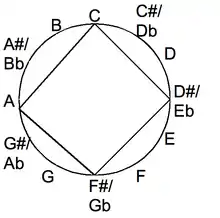Repetitive tuning
Repetitive tunings are a type of alternative tunings for the guitar. A repetitive tuning begins with a list of notes that is duplicated, either at unison or at higher octaves.


Among regular tunings, there are four repetitive-tunings (besides trivially repetitive tunings such as C-C-C-C-C-C); this article discusses three minor-thirds tuning, major-thirds tuning, and augmented-fourths tuning (but not major seconds tuning, which is not repetitive on six strings). Among open tunings, there are repetitive versions of open C tuning and open G tuning, which have been associated with the English and Russian guitars, respectively.
Repetition eases the learning of fretboard and chords and eases improvisation. For example, in major-thirds tuning, chords are raised an octave by shifting fingers by three strings on the same frets.[2]
Repetitive tunings are listed after their number of open pitches. For example, the repetitive open-C tuning C-E-G-C-E-G has three open-pitches, each of which is associated with repeated notes {(C,C), (E,E), (G,G)}.
One

The trivial tuning repeats the same note every string. It is also called a unison regular tuning.
- C-C-C-C-C-C.[3]
Other trivial-tunings repeat their single notes on a higher octave (or on higher octaves), for example,
- C-C-c-c-c'-c'.
Two
The following tunings repeat their notes on a higher octave after two strings:
- Augmented-fourths tuning, for example, B-F-b-f-b'-f'.
Any note fingered on one string can be fingered on two other strings. Thus chords can be fingered in many ways in augmented-fourths tuning. It is also a regular tuning in which the interval between its strings is a tritone (augmented fourth).[4]
There are other tunings for the cittern.[6]
- Alternating fourths and fifths tuning, such as A1-D2-A2-D3-A3-D4. (ADADAD)
This kind of tuning can also be called modal D or open D5 as it contains a D chord without a third. It is also used on other instruments, e.g. fiddle, mandolin and the Irish bouzouki.
Three


The following tunings repeat their notes after three strings:
- Major-thirds tuning, such as E-G♯-c-e-g♯-c' and
- D♯-G-B-D♯-G-B-D♯,[7]
Chord inversion is especially simple in major-thirds tuning. Chords are inverted simply by raising one or two notes three strings. The raised notes are played with the same finger as the original notes. The major-thirds tuning is also a regular tuning having a major third interval between strings.[1][2]
- Open G tuning, which is used as D', G', B, D, g, b, d' for the (7-string) Russian guitar.[8][9][10][11]
- Open C tuning.[12] For the English guitar's open C tuning,[13] there are ten strings—of which the highest eight are paired in four courses (duplicated strings), C E GG cc ee gg.
Four

In each minor-thirds tuning, every interval between successive strings is a minor third. It repeats its open-notes after four strings. Doubled notes have different sounds because of differing "string widths, tensions and tunings, and [they] reinforce each other, like the doubled strings of a twelve string guitar add chorusing and depth," according to William Sethares.[14]
In the minor-thirds tuning beginning with C,
- C-D♯-F♯-a-c-d♯
the open strings contain the notes (c, d♯, f♯) of the diminished C chord. The minor-thirds tuning is also a regular tuning, which has a minor third interval between consecutive strings.[14]
See also
- Scordatura, alternative tunings of stringed instruments
- Stringed instrument tunings
Notes
- Kirkeby (2012, "Fretmaps, major chords: Major Triads"): Kirkeby, Ole (1 March 2012). "Major thirds tuning". m3guitar.com. cited by Sethares (2011) and Griewank (2010, p. 1). Retrieved 10 June 2012.
- Griewank (2010, p. 10)
- Sethares (2001, "Regular tunings", p. 53; and "The augmented fourths tuning" 60):
Sethares, Bill (2001). "Regular tunings". Alternate tuning guide (PDF). Madison, Wisconsin: University of Wisconsin; Department of Electrical Engineering. pp. 52–67. Retrieved 9 September 2012.
- Sethares (2001, "The augmented fourth tuning", p. 60)
- Sethares (2001i, "Instrumental tunings: Cittern tuning two, p. 42)
- Sethares (2001i, pp. 34 and 41–42)
Sethares, Bill (2001i). "Instrumental tunings". Alternate tuning guide (PDF). Madison, Wisconsin: University of Wisconsin; Department of Electrical Engineering. pp. 34–51. Retrieved 12 September 2012.
- Sethares (2001, "The major third tuning", pp. 56–57)
- Ophee, Matanya (ed.). 19th Century etudes for the Russian 7-string guitar in G Op. The Russian Collection. Vol. 9. Editions Orphee. PR.494028230.
- Ophee, Matanya (ed.). Selected Concert Works for the Russian 7-String Guitar in G open tuning. The Russian Collection. Vol. 10 ("X"). Editions Orphee. PR.494028240.
- Smith, Gerald Stanton (1984). Songs to seven strings: Russian guitar poetry and Soviet "mass song". Soviet history, politics, society, and thought. Indiana University Press. pp. 1–271. ISBN 978-0-253-35391-7.
- Timofeyev, Oleg V. (1999). The golden age of the Russian guitar: Repertoire, performance practice, and social function of the Russian seven-string guitar music, 1800-1850. Duke University, Department of Music. pp. 1–584. University Microfilms (UMI), Ann Arbor, Michigan, number 9928880.
- Sethares (2001o, The open C tuning, p. 18):
Sethares, Bill (2001o). "Open tunings". Alternate tuning guide (PDF). Madison, Wisconsin: University of Wisconsin; Department of Electrical Engineering. pp. 16–33. Retrieved 9 September 2012.
- Hannu Annala; Heiki Mätlik (2007). "Composers for other plucked instruments: Rudolf Straube (1717-1785)". Handbook of Guitar and Lute Composers. Translated by Katarina Backman. Mel Bay. p. 30. ISBN 978-0-7866-5844-2.
- Sethares (2001, "The minor third tuning", p. 54)
References
- Griewank, Andreas (1 January 2010), Tuning guitars and reading music in major thirds, Matheon preprints, vol. 695, Berlin: DFG research center "MATHEON, Mathematics for key technologies" Berlin, MSC-Classification 97M80 Arts. Music. Language. Architecture. Postscript file and Pdf file, archived from the original on 8 November 2012
- Sethares, William A. (2011). "Alternate tuning guide". Madison, Wisconsin: University of Wisconsin; Department of Electrical Engineering. 2010 PDF version by Bill Sethares. Retrieved 19 May 2012.